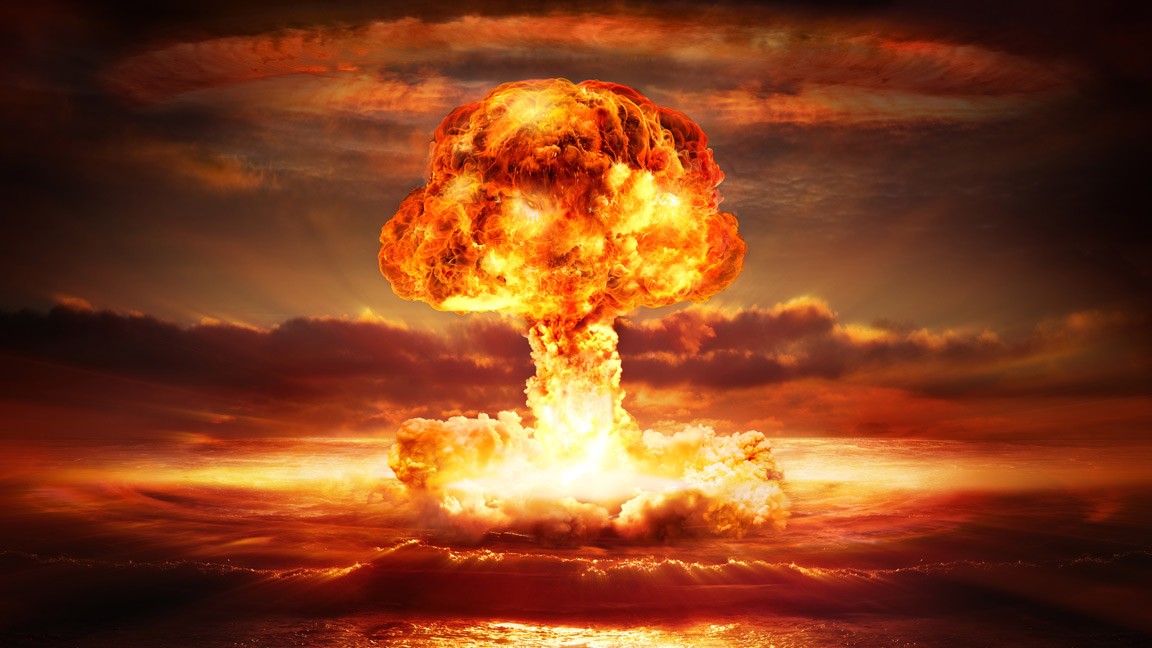Explosions nucléaires : Tsar Bomba
La conception initiale à trois étages (codée A620EN, non testée) était capable de produire environ 100 Mt (420 PJ) par fission rapide, 3 000 fois la taille des bombes d’Hiroshima et de Nagasaki, mais on pensait que cela aurait causé trop les retombées nucléaires et l’avion qui a livré la bombe n’aurait pas eu le temps d’échapper à l’explosion.
Pour limiter la quantité de retombées, le troisième étage et peut-être le deuxième étage avaient un sabotage en plomb au lieu d’un sabotage de fusion à l’uranium-238 (ce qui amplifie considérablement la réaction en fissionnant des atomes d’uranium avec des neutrons rapides issus de la réaction de fusion).
Cela éliminait la fission rapide par les neutrons de l’étage de fusion de sorte qu’environ 97 % du rendement total résultaient de la fusion thermonucléaire seule (en tant que telle, c’était l’une des bombes nucléaires « les plus propres » jamais créées, générant une très faible quantité de retombées par rapport à son rendement). Il y avait une forte incitation pour cette modification puisque la plupart des retombées d’un test de la bombe seraient probablement descendues sur le territoire soviétique peuplé.
![]()
![]()
![]()
![]()
![]()
Explozii nucleare : Tarul Bomba
Proiectul inițial în trei etape (codat A620EN, netestat) a reușit să producă aproximativ 100 Mt (420 PJ) prin fisiune rapidă, de 3.000 de ori mai mare decât bombele Hiroshima și Nagasaki, dar se credea că aeronava care a livrat bomba nu putea evita radiațiile.
Pentru a limita cantitatea de căderi nucleare, a treia etapă și, probabil, a doua etapă au avut sabotaj cu plumb în loc de sabotaj de fuziune cu uraniu-238 (care amplifică foarte mult reacția prin divizarea atomilor de uraniu cu neutroni, rezultate rapide ale reacției de fuziune).
Acest lucru a eliminat fisiunea rapidă de către neutroni din etapa de fuziune, astfel încât aproximativ 97% din randamentul total provenea doar din fuziunea termonucleară (ca atare, a fost una dintre cele mai « curate » bombe nucleare. Niciodată creată, generând o cantitate foarte mică de spinoffs comparativ cu randamentul acestuia). A existat un puternic stimulent pentru această modificare, deoarece cea mai mare parte a consecințelor unui test de bombă ar fi coborât probabil pe teritoriul sovietic populat.
![]()
![]()
![]()
![]()
![]()
Nuclear explosions : Tsar Bomb
The initial three-stage design (coded A620EN, not tested) was capable of yielding approximately 100 Mt (420 PJ) through fast fission, 3,000 times the size of the Hiroshima and Nagasaki bombs, but it was thought that it would have caused too much nuclear fallout, and the aircraft delivering the bomb would not have had enough time to escape the explosion.
To limit the amount of fallout, the third stage and possibly the second stage had a lead tamper instead of a uranium-238 fusion tamper (which greatly amplifies the reaction by fissioning uranium atoms with fast neutrons from the fusion reaction).
This eliminated fast fission by the fusion-stage neutrons so that approximately 97% of the total yield resulted from thermonuclear fusion alone (as such, it was one of the « cleanest » nuclear bombs ever created, generating a very low amount of fallout relative to its yield). There was a strong incentive for this modification since most of the fallout from a test of the bomb would likely have descended on populated Soviet territory.
Stéphane Guibert (Facebook) / Stéphane Guibert (VK)
![]()

